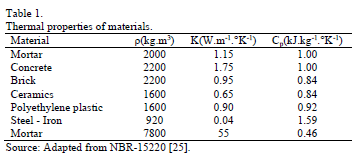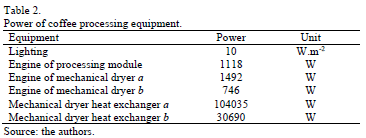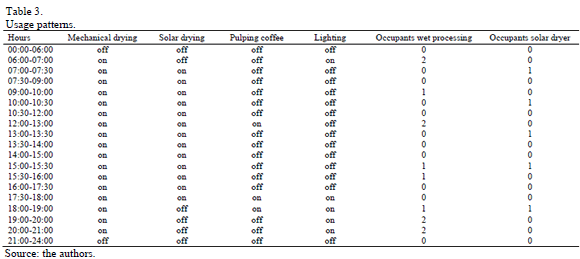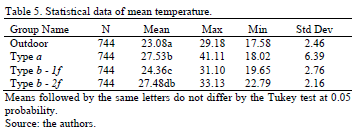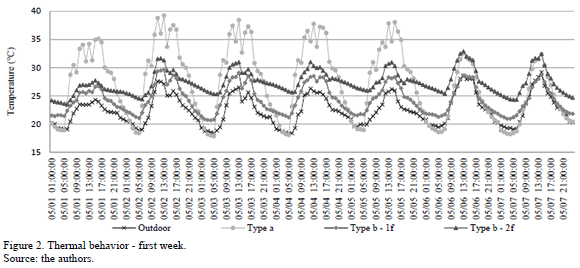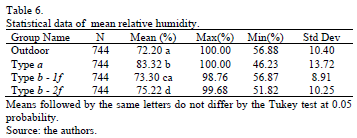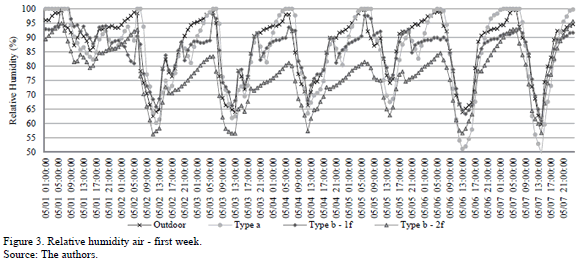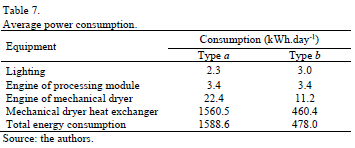Serviços Personalizados
Journal
Artigo
Indicadores
-
 Citado por SciELO
Citado por SciELO -
 Acessos
Acessos
Links relacionados
-
 Citado por Google
Citado por Google -
 Similares em
SciELO
Similares em
SciELO -
 Similares em Google
Similares em Google
Compartilhar
DYNA
versão impressa ISSN 0012-7353
Dyna rev.fac.nac.minas vol.82 no.194 Medellín nov./dez. 2015
https://doi.org/10.15446/dyna.v82n194.49526
DOI: http://dx.doi.org/10.15446/dyna.v82n194.49526
Simulation of a thermal environment in two buildings for the wet processing of coffee
Simulación del ambiente térmico en dos edificaciones para beneficio húmedo de café
Robinson Osorio-Hernandez a, Lina Marcela Guerra-Garcia b, Ilda de Fátima Ferreira-Tinôco c, Jairo Alexander Osorio-Saraz d & Iván Darío Aristizábal-Torres e
a Departamento de Engenharia Agrícola, Universidade Federal de Viçosa, Viçosa, Brasil. robinson.hernandez@ufv.br
b Departamento de Engenharia Agrícola, Universidade Federal de Viçosa, Viçosa, Brasil. lina.garcia@ufv.br
c Departamento de Engenharia Agrícola, Universidade Federal de Viçosa, Viçosa, Brasil. iftinoco@ufv.br
d Departamento de Ingeniería Agrícola y Alimentos, Universidad Nacional de Colombia, Medellín, Colombia. aosorio@unal.edu.co
e Departamento de Ingeniería Agrícola y Alimentos, Universidad Nacional de Colombia, Medellín, Colombia. idaristi@unal.edu.co
Received: March 6th, 2015. Received in revised form: May 4th, 2015. Accepted: May 12th, 2015.
This work is licensed under a Creative Commons Attribution-NonCommercial-NoDerivatives 4.0 International License.
Abstract
This study aimed to compare the bioclimate and energy consumption of two coffee wet processing facilities in Colombia, with two typical types of Colombian coffee, using computer simulation. Specifically, we evaluated the effect of the heat generated by machines and the effect of the natural ventilation area on temperature and relative air humidity inside these buildings and their energy consumption. The postharvest plant with typology b gave the best results in terms of temperature and relative humidity suitable to preserve the quality of the coffee bean. Its approximate energy consumption was 30% of the total consumed by typology a.
Keywords: bioclimate, quality coffee, wet beneficio of coffee, coffee drying, energy consumption.
Resumen
Este estudio tuvo como objetivo hacer una comparación bioclimática y de consumo energético entre dos instalaciones de beneficio húmedo de café en Colombia, con dos tipologías típicas de la zona cafetera colombiana, por medio de simulación computacional, evaluando específicamente el efecto del calor generado por las máquinas y el efecto del área de ventilación natural sobre la temperatura y la humedad relativa del aire en el interior de éstas construcciones y su consumo energético. El beneficiadero de café de tipología b presentó los mejores resultados en términos de temperatura y humedad relativa para conservar la calidad del grano de café y su consumo energético aproximado fue 30% del total consumido por la tipología a.
Palabras clave: bioclima; calidad de café; beneficio húmedo de café; secado de café; consumo energético.
1. Introduction
Coffee has great economic and social importance [1,2]. It is the third most important food product in the world after wheat and sugar, and the coffee industry employs 125 million people worldwide [3]. Nearly 25 million households over 50 countries produce coffee in tropical and subtropical regions of Asia, Africa and Latin America. There are also coffee growing regions in the United States (Hawaii, Puerto Rico) and Australia [4].
Nowadays it is observed that the specialty coffee market (market value-added) is experiencing a continuous growth in demand, mainly because the world is increasingly enjoying good coffee and the highest quality beverages [5].
Various factors determine the formation of the flavors and aromas of the coffee beverage, the final appearance of the grain and thus the value of the final product. These factors include the genetic strain, variety, edaphological factors, the crop and climatic factors, but harvest and postharvest management are key issues [6].
The postharvest process is one of the primary points for the preservation of the qualitative characteristics of the coffee bean [7], as long as appropriate techniques that meet the climatic conditions of the region and socioeconomics of the producer are used [6]. In Colombia the coffee is wet processed [8]. The wet processing of coffee includes depulping, fermentation, washing and drying the coffee bean.
The removal of the epicarp and mesocarp, depending on the environmental conditions in the drying coffee, can reduce the risk of unwanted fermentation [9]. Drying is considered a critical process step, which decreases the product moisture content from 55-60% wet basis (wb) to 10-12% wb (the grain moisture balance with the environment), the reduction being due to water activity and metabolic processes. The coffee is dried in the interest of maintaining its quality and storing it for extended periods of time [10,11].
The main problems in the cup (taste) arise from poor drying and storage. Some of these problems even present biological and chemical risks with the product and can lead to a product that is unfit for human consumption [12,13].
Although less than 10% of Colombian coffee growers use mechanical drying, they are responsible for approximately 70% of the volume of coffee that is produced in Colombia [14].
Furthermore, according to [15], solar drying is the most commonly used method for preserving agricultural products in most developing countries. Solar drying of coffee is used by 90% of Colombian coffee producers and uses a renewable energy source (the most abundant on the planet) it is also highly appreciated in the specialty coffee market. This is important to conserve the environment, but also because nowadays it is observed that the specialty coffee market is experiencing a continuous growth in demand [5].
Poor control and design of coffee postharvest plants (buildings for the wet processing of coffee) can compromise product quality due to inadequate bioclimatic environments. Humid environments and high temperatures during storage are risk conditions that can physically damage the grain, causing decomposition and deterioration in the quality of the product [13].
Temperatures higher than 50°C can kill the seed of coffee and begin the process of decomposition. According to [15], losses of fruits and vegetables during drying in developing countries are estimated at 30-40% of production, but they also report that postharvest losses can be reduced dramatically with optimal use (control) of well-designed solar drying systems.
In Arabica coffee storage, the discoloration defect has a rate that is directly related to the conditions of the storage environment; the higher the temperature and relative humidity, the faster the coffee bleaches. According to [16,17], a marked loss of color can be observed from the eighth day of storage conditions at temperatures above 20°C and with a relative humidity greater than 52%.
To analyze and suggest bioclimatic and air quality solutions within agro-industrial buildings, the application of mathematical and computational modeling is increasingly used and important [18]. Simulation is a very interesting tool in the design and evaluation of buildings, showing how those buildings involve very complex aspects such as energy flows, transient stochastic occupancy patterns, etc., that traditional design methods based on experience or experimentation cannot quantify satisfactorily [19].
Numerous analyses of the bioclimatic and air quality in rural buildings have been done with software based on CFD [18], but other software may also be used. One of the most popular computer programs for energy and bioclimatic simulation for buildings is EnergyPlusTM [20], which is a free open source software developed by the US Department of Energy (DoE).
Its main input variables are: 3D building design, construction materials, internal equipment, and climate variables of the site of the building. This program calculates the energy efficiency, bioclimatic variables and air quality within buildings, across balances of mass, energy and chemical composition.
This study aimed to make a simulation of the thermal environment in EnergyPlusTM software for two typical installations of the Colombian coffee postharvest, in order to compare and analyze the internal bioclimatic conditions for grain quality.
2. Material and methods
The two buildings are located in the municipality of Barbosa (Antioquia-Colombia) at coordinates 6°26'15"N, 75°19'50"W, at an altitude of 1700 m (the two buildings are neighboring properties). The two farms produce the same amount of coffee, with a coffee cherry production of about 125,000 kg/year-1 (yielding 25,000 kg/year-1 of parchment coffee). This study was conducted during the month of May 2014.
It was drawn in the 3D geometry SketchUp® program, for each of the two structures (Fig. 1). The first geometry, type a, has two floors (of equal size) in stepped form. On the first floor is the mechanical drying area, and the second floor is the area for pulped and fermented coffee; in this typology, all the coffee is mechanically dried. The dimensions of this building are: 5.50 m wide x 9.50 m long x 4 m high.
Type b has two separate floors: the first floor is the area for pulping, fermentation and mechanical drying of the coffee and has dimensions of 11 m long x 6 m wide x 3.5 m high. The second floor consists of a parabolic solar dryer with plastic covering, measuring 11m long x 6m wide x 2.30m high. Between the first and second floor, there is a lightweight concrete and brick slab.
Each floor of type b was analyzed as an independent thermal area, while type a was analyzed as a single thermal zone. The thermal zones were created using the plug-in Open Studio (EnergyPlusTM), to generate an idf file for each type. In each thermal zone, the thermal characteristics of the materials and other details of each patterned surface are described [21].
Type a has 15 cm of unplastered brick cladding, with two windows on the western side of 1.15 m x 0.6 m, and a window in the roof discontinuity of 4.80 m x 0.30 m. These windows remain open all the time (unglazed). The roof is made of fiber cement tiles.
The first floor of type b has brick walls 0.15 m thick, without plaster, for the initial two meters. Between 2 m and 3.5 m height, the walls are of perforated brick, in the form of 10 windows. We calculated the air exchange area of the perforated brick windows and the interference with the passage of light.
To simplify the geometric model, 10 windows were made with the effective area of the perforated brick, and shading devices were inserted to simulate the interference with the light. The calculated area of the simplified windows was 1.92 m2 for each window on the north and south walls, and 1.5 m2 for each window on the east and west walls.
The first floor inside the building contains scales, fermentation tanks, and a coffee hydraulic classifier; these were added to the concrete at the bottom of the western wall, with a volume of 3.5 m3 in order to account for the effect of thermal inertia of this mass. The same process was used for the type a building.
The second floor corresponds to the parabolic solar dryer of the coffee, which has a polyethylene plastic cover and a coffee layer with an average humidity of 33% wb and 0.03m thick on the slab. The solar dryer has two openings of 1.6 m2 each for natural ventilation during the day. At night it is assumed that the solar dryer was closed.
In type a and on the first floor of type b there are lights, a humidity processing module to peel and sort coffee with a capacity of 2000 kg of coffee cherry per hour, and a mechanical drying machine with a capacity of 750 kg of parchment coffee per day for type a, and of 262.5 kg of parchment coffee per day for type b.
For the thermal properties of the stripped coffee we used equations 1 and 2 proposed by [22], for the specific heat ( , J·kg-1·°K-1 ) and density of the coffee (
, J·kg-1·°K-1 ) and density of the coffee ( , kg.m-3) These properties are functions of the moisture content of the product on a dry basis (
, kg.m-3) These properties are functions of the moisture content of the product on a dry basis ( , decimal dry basis).
, decimal dry basis).

To calculate the thermal properties of composite materials and the thickness and equivalent thermal resistance of the various construction materials [23], we used the method of simplification layers of materials [24].
For calculation of the energy balance, it is necessary to calculate the heat generated within each building (heat generated by machines and human metabolism, the reaction energy generated in the fermentation process of coffee was not considered). Table 2 shows the heat values of the machines and lighting.
The heat exchanger drying machine "a" used coal (anthracite) as fuel, which, according to [25,26], has a consumption of 0.224 kg of coal per kg of dry parchment coffee, with a calorific value of 33440 kJ.kg-1. The heat exchanger drying machine "b" uses coffee husk as fuel which, according to [12] has a husk consumption of 0.352 kg per kg of dry parchment coffee with a calorific value of 17936 kJ.kg-1.
The metabolic rate, i.e., the metabolic energy that the human body expends while performing physical activities, varies from person to person, according to the activity and working conditions performed. The value of 423 W.person-1 was used in this study for the metabolic rate; according to [27], this value corresponds to heavy work activity and handling 50 kg sacks.
Table 3 shows the usage patterns of the coffee processing plant models "a" and "b". Mechanical drying and pulping require the same working hours for both typologies. The solar dryer (b-2f) is only opened during the day to encourage the mass exchange of water, and is closed at night to retain thermal energy, prevent condensation and prevent the ingress of moist air from outdoors.
The internal environment of the building was simulated for the month of May, which represents the first harvest of the year; the second harvest starts in October, coinciding with the bimodal behavior of rainfall in this part of Colombia [28].
A statistical analysis of variance (p< 0.001) and test media (Tukey, p<0.050) was made for the analysis of temperature and relative humidity (hourly), with four treatments: outdoor, type a, type b-1f (first floor), and type b-2f (second floor or solar dryer).
Finally, we made a graphical analysis of the behavior of temperature and relative humidity for the first experimental week and a comparative analysis of the energy consumption of the two coffee processing plants.
3. Results and discussion
Table 4 presents data on the volume of the buildings and their respective areas of natural ventilation. It is observed that the type a building has the smallest area of natural ventilation and a lower ratio of natural ventilation area to volume built.
To optimize the drying process, it not only requires energy transfer, but is important to provide optimum conditions for mass transfer, which in this context refers to having a sufficient area of natural ventilation to evacuate the vapor mass produced in the coffee drying process. According to [15] drying is defined as the process of moisture removal using simultaneous heat and mass transfer. In this context, the type a building has the worst conditions for mass exchange.
Table 5 shows the statistical analysis of the mean temperature, and it can be observed that warmer environments are present within type a and the solar dryer (type b-2f), between which there is no significant statistical difference. The type a building had higher temperature variance (indicative of scattering data), also presenting the highest maximum temperature and lowest minimum temperature of the four treatments.
Fig. 2 shows the thermal behavior during the first experimental week of building types a and b, and outdoors. It is observed that type a presents the warmest environment during the day and the coolest environment at night. This thermal behavior is because of the fiber cement roof, which has less thermal inertia than the concrete slab, and because this building has the smallest area of natural ventilation. Although the type b-2f has a plastic cover, it has the largest natural ventilation area during the day and at night is closed, retaining some heat, thus achieving higher thermal stability than type a.
The minimum peaks during the day are due to the door opening when employees come to work pulping or drying the coffee.
Table 6 presents the statistical data of mean relative humidity content. As in the case of temperature, the type a building had the highest and most variable content of relative humidity, with a mean value of 83.32%, and a maximum value of 100%, i.e., condensation occurred within the construction. The type b showed similar behavior to the outdoors, but with less variance and without indoor saturation.
Fig. 3 shows the behavior of the relative humidity during the first experimental week, and it is observed that the internal environment of the type a building is saturated. The minimum peaks during the day are due to the door opening when employees come to work pulping or drying the coffee.
The saturation of the air makes the environment suffocating for the worker and thus uncomfortable to work in. This is also a dangerous environment for coffee quality, since it is conducive to the biological risk of the creation of fungi and bacteria (hot and humid environment), meaning that the grain may be re-moistened and damaged [13].
The type b building, on both the first and second floors, is at times close to saturation, but does not become fully saturated, and thus represents a more suitable environment for the quality of the coffee bean, especially in the solar dryer. But the wet and hot weather is a bioclimatic limitation for naturally ventilated facilities as in this case.
In Colombia, it is common to store dry parchment coffee during the harvest in wet processing coffee buildings for several weeks, in order to increase the volume of dry parchment coffee to transport and save money on freight costs.
According to [16] the coffee should not be stored for more than 8 days in an environment with a relative humidity above 52% and temperatures above 20°C. With this in mind, the two types of processing are not suitable for storing coffee for more than a week. The dried parchment coffee should be stored in suitable cellars.
Table 7 shows the energy consumption data of building types a and b, from which it can be observed that the highest power consumption was that of type a, with a value 3.3 times the consumption of type b.
The biggest difference in power consumption is in the mechanical drying, since type b dries most of its coffee with the sun as the energy source. Although its mechanical dryer has 3 times less drying capacity (than type a), the heat exchanger uses coffee husk as an energy source, which according to [26] consumes only 84.3% of the energy consumed by the coal heat exchanger used in type a, making type b more energy-efficient in coffee processing and therefore more environmentally sustainable.
4. Conclusions
The type a building has the internal environment that offers the best compromise between the coffee bean quality and the highest temperatures and the highest relative indoor moisture content.
Type b is more energy-efficient than type a, as its power consumption is only 30% of the consumption of type a.
The weather conditions of the place where the two buildings are located (humid and hot) for both type a and type b are unsuitable for storing or keeping the coffee for periods longer than 8 days.
Acknowledgments
The authors thank the Departamento de Engenharia Agrícola - Universidade Federal de Viçosa, CAPES, FAPEMIG, CNPq, Departamento de Ingeniería Agrícola y Alimentos - Universidad Nacional de Colombia Sede Medellín, La Talega Coffee Company - Manuel Bolivar Coffee Farmer, and Federación Nacional de Cafeteros de Colombia for their valuable assistance in the development of this research.
References
[1] López, M.F., Sistemas de lógica difusa en el proceso de secado de café en lecho fluidizado, Revista Ingeniería e Investigación, 25(3), pp. 84-91, 2005. [ Links ]
[2] López, M.F., Secado de café en lecho fluidizado, Revista Ingeniería e Investigación, 26(1), pp. 25-29, 2006. [ Links ]
[3] Wintgens, J.N., Coffee: Growing, processing, sustainable production. A guidebook for growers, processors, traders and researchers., 2nd Ed. Wiley-Vch, 2009. [ Links ]
[4] Federación Nacional de Cafeteros de Colombia. About coffee. Much more than a drink social impact. [Online]. 2015. [date of reference February 17th of 2015]. Available at: http://www.cafedecolombia.com/particulares/en/sobre_el_cafe/mucho_mas_que_una_bebida/impacto_social/. [ Links ]
[5] Fonseca, J.J., Lacerda-Filho, A.F., Melo, E.C. and Teixeira, E.C., Secagem combinada de café cereja descascado, Rev. Eng. Na Agric. Viçosa, 17(3), pp. 244-258, 2009. [ Links ]
[6] Ribeiro, B.B., Mendonça, L.L., Dias, R.A.A., Assis, G.A. and Marques, A.C., Parâmetros qualitativos do café provenientes de diferentes processamentos na pós-colheita, Agrarian, 4(14), pp. 273-279, 2011. [ Links ]
[7] Carvajal, J.J. Aristizabal, I.D. y Oliveros, C.E., Evaluación de propiedades físicas y mecánicas del fruto de café (Coffea Arabica l. var. Colombia) durante su desarrollo y maduración, DYNA, 79(173), pp. 116-124, 2012. [ Links ]
[8] Buitrago, O.B. Ospina, M.E. y álvarez, J.G., Implementación del secado mecánico de café en carros secadores, Revista Ingeniería e Investigación, 25, pp. 3-9, 1991. [ Links ]
[9] Borém, F.M., Ribeiro, D.M.A., Pereira, R.G.F., da Rosa, S.D.V.F. and de Morais, A.R., Qualidade do café submetido a diferentes temperaturas, fluxos de ar e períodos de pré-secagem, Ciênc. agrotec., Lavras., 32(5), pp.1609-1615, 2008. [ Links ]
[10] Ciro, H.J., Rodríguez, M.C. and Castaño, J.L.L., Secado de Café en Lecho Fijo con Intermitencia Térmica y Flujo de Aire Pulsado, Rev. Fac. Nac. Agron. Medellin, 64(2), pp. 6247-6255, 2011. [ Links ]
[11] Ciro, H.J., Abud, L.C. and Perez, L.R., Numerical simulation of thin layer coffee drying by control volumes, DYNA, 77(163), pp. 270-278, 2010. [ Links ]
[12] Oliveros, C.E. Peñuela, A. y Pabon, J., Gravimet SM: Tecnología para medir la humedad del café en el secado en silos, Cenicafé, 433, 1-8, 2013. [ Links ]
[13] Puerta, G.I., Riesgos para la calidad y la inocuidad del café en el secado, Cenicafé, 378, pp. 1-8, 2008. [ Links ]
[14] González, C., Sanz, J. y Oliveros, C.E. Control de caudal y temperatura de aire en el secado mecánico de café, Cenicafe, 61(4), pp. 281-296, 2010. [ Links ]
[15] El-Sebaii A.A. and Shalaby, S.M., Solar drying of agricultural products: A review, Renew. Sustain. Energy Rev., 16(1), pp. 37-43, 2012. DOI: 10.1016/j.rser.2011.07.134 [ Links ]
[16] Vilela, E.R., Chandra, P.K. and de Oliveira, G., Efeito da temperatura e umidade relativa no branqueamento de grãos de café, Rev. Bras. Armazenamento, Especial-Café 1, pp. 31-37, 2000. [ Links ]
[17] Corrêa, P.C. Júnior, P. da Silva, F. and Ribeiro, D.M., Qualidade dos grãos de café (Coffea arabica L.) durante o armazenamento em condições diversas, Rev. Bras. Armazenamento Espec. Café Viçosa, 7(1), pp. 136-147, 2003. [ Links ]
[18] Norton, T., Grant, J., Fallon, R. and Sun, D.W., Assessing the ventilation effectiveness of naturally ventilated livestock buildings under wind dominated conditions using computational fluid dynamics, Biosyst. Eng., 103(1), pp. 78-99, 2009. DOI: 10.1016/j.biosystemseng.2009.02.007 [ Links ]
[19] Bre, F. Fachinotti, V.D. y Bearzot, G., Simulación computacional para la mejora de la eficiencia energética en la climatización de viviendas, Mecánica Comput., 32(1), pp. 3107-3119, 2013. [ Links ]
[20] DoE, Energyplus engineering reference, Ref. EnergyPlus Calc., 2012. [ Links ]
[21] DoE, EnergyPlus, Input Output Reference: The Encyclopedic Reference to EnergyPlus Input and Output, USA Dep. Energy, 2014. [ Links ]
[22] Montoya, E.C., Oliveros, C.E. y Mejía, G., Optimización operacional del secador intermitente de flujos concurrentes para café pergamino. Cenicafé, 41(1), pp. 19-33, 1990. [ Links ]
[23] INMETRO, Qualidade e Tecnologia INMETRO, Anexo V - Portaria no. 50, de 01 de fevereiro de 2013. 2013. [ Links ]
[24] LabEEE., Laboratório de Eficiência Energética em Edificações, Florianópolis Universidade Fed. St. Catarina Sd Homepage Laboratório Pesqui. Disponível Em Httpwww Labeee Ufsc Br, 2015. [ Links ]
[25] ABNT, 15220-2. Desempenho Térmico de Edificações-Parte 2: Métodos de cálculo da transmitância térmica, da capacidade térmica, do atraso térmico e do fator de calor solar de elementos e componentes de edificações. Janeiro, 2003. [ Links ]
[26] Oliveros, C.E., Sanz, J.R., Ramirez, C.A. and Peñuela, A.E., Aprovechamiento eficiente de la energía en el secado mecánico del café, Cenicafé, 380, pp. 1-8, 2009. [ Links ]
[27] ASHRAE, Fundamentals, Am. Soc. Heat. Refrig. Air Cond. Eng. Atlanta, 111, 2001. [ Links ]
[28] Oviedo, N.E. y Torres, A., Atenuación hídrica y beneficios hidrológicos debido a la implementación de techos verdes ecoproductivos en zonas urbanas marginadas, Ing. Univ., 18(2), pp. 291-308, 2014. DOI: 10.11144/Javeriana.IYU18-2.hahb [ Links ]
R. Osorio-Hernandez, received the BSc. Eng in Agricultural Engineering in 2006 from the Universidad Nacional de Colombia - Medellin, Colombia, the MSc. degree in Agricultural Engineering in 2012 from the Universidade Federal de Viçosa, Brazil. Currently completing his doctoral studies in Agricultural Engineering at the Universidade Federal de Viçosa, Brazil. From 2006 to 2010, he worked for the National Federation Coffee Growers of Colombia, in Medellin, within the area of post-harvest and quality of coffee, at the same time, from 2007 to 2010, and 2012, he worked for the Universidad Nacional de Colombia, as ocasional professor of electrotechnics and rural constructions, and from 2012 to 2014, he worked for the National Federation Coffee Growers of Colombia, in the area of quality assurance coffee, as an analyst in building design for coffee processing. His research areas include: bioclimatic simulation and energy of rural buildings, postharvest coffee, and energy in agriculture. ORCID: 0000-0002-8698-7234
L.M. Guerra-Garcia, received the BSc. in Architecture in 2004 from the Universidad Nacional de Colombia - Medellin, Colombia, the MSc. degree in Agricultural Engineering in 2012 at the Universidade Federal de Viçosa, Brazil. Currently completing her doctoral studies in Agricultural Engineering, in rural constructions and ambience area, of the Universidade Federal de Viçosa, Brazil. From 2004 to 2009, she worked in different companies in design and / or construction of social housing, commercial buildings, religious and agricultural use. In 2014 she worked for the Universidad Nacional de Colombia - Medellin, as an occasional teacher in rural constructions. Her research interests include: bioclimatic simulation and energy of buildings, rural architecture and rural constructions and ambience. ORCID: 0000-0001-9115-9057
I.F. Ferreira-Tinôco, has a BSc. in Agricultural Engineer in 1980, has a MSc degree in Agricultural Engineer in 1988, both achieved at the Federal University of Lavras, Brazil. Mrs. Tinôco has a DSc. degree in Animal Sciences in 1996, from the Federal University of Minas Gerais, Brazil. She is a full professor at the Department of Agricultural Engineering (DEA) of Federal University of Viçosa (UFV) and coordinates the UFV branch of the following scientific exchange programs: (1) CAPES/FIPSE Agreement involving the University of Illinois and University of Purdue, in the U.S.A.; (2) Umbrella Agreement amongst UFV and Iowa State University, University of Kentucky (both in the U.S.A.); (3) Scientific and Technical Agreement amongst UFV and University of évora (Portugal), Universidad Nacional de Colombia (Colombia), Iowa State University, University of Kentucky (U.S.A.), and Erasmus agreement with the University of Florence (Italy). Professor Tinôco also coordinates the Center for Research in Animal Microenvironment and Agri-Industrial Systems Engineering (AMBIAGRO) and is the President of the DEA-UFV Internation Relations Committee. Her research areas are design of rural structures and evaporative cooling systems, thermal confort for animals, air quality and animal welfare. ORCID: 0000-0002-4557-8071
J.A. Osorio Saraz, received the BSc. Eng in Agricultural Engineering in 1998 from the Universidad Nacional de Colombia - Medellin, Colombia, is Specialized in Environmental Legislation in 2001 from the Universidad de Medellin, Colombia, and has a MSc degree in Materials Engineering in 2006 from the Universidad Nacional de Colombia - Medellin, Colombia. In 2011 he achieved a Dr. degree in Agricultural Engineering from the Universidade Federal de Viçosa, Brazil. Since 2003 Dr. Osorio is professor at the Universidad Nacional de Colombia - Medellin, Colombia, teaching and rural constructions, bamboo constructions, computational modeling for livestock housing, air quality and animal welfare. Dr. Osorio is the Dean of the Faculty of Agricultural Sciences at Universidad Nacional de Colombia - Medellin, since 2012. ORCID: 0000-0002-4358-3600
I.D. Aristizábal-Torres, is BSc. Eng. in Agricultural Engineering in 1995 from Universidad Nacional de Colombia - Medellin, Colombia, Dr. in Agricultural Mechanization and Technology in 2006, of Universidad Politécnica de Valencia, Spain. Associate professor at the Universidad Nacional de Colombia - Medellin, since 2000- current, within Department of Agricultural and food engineering at the Faculty of Agricultural Sciences. Coordinator research group Agricultural Engineering (since 2012- current). Work areas; agricultural mechanization, agro-industrial processes and properties of agricultural products (fruits, grains). ORCID: 0000-0003-1913-6832













